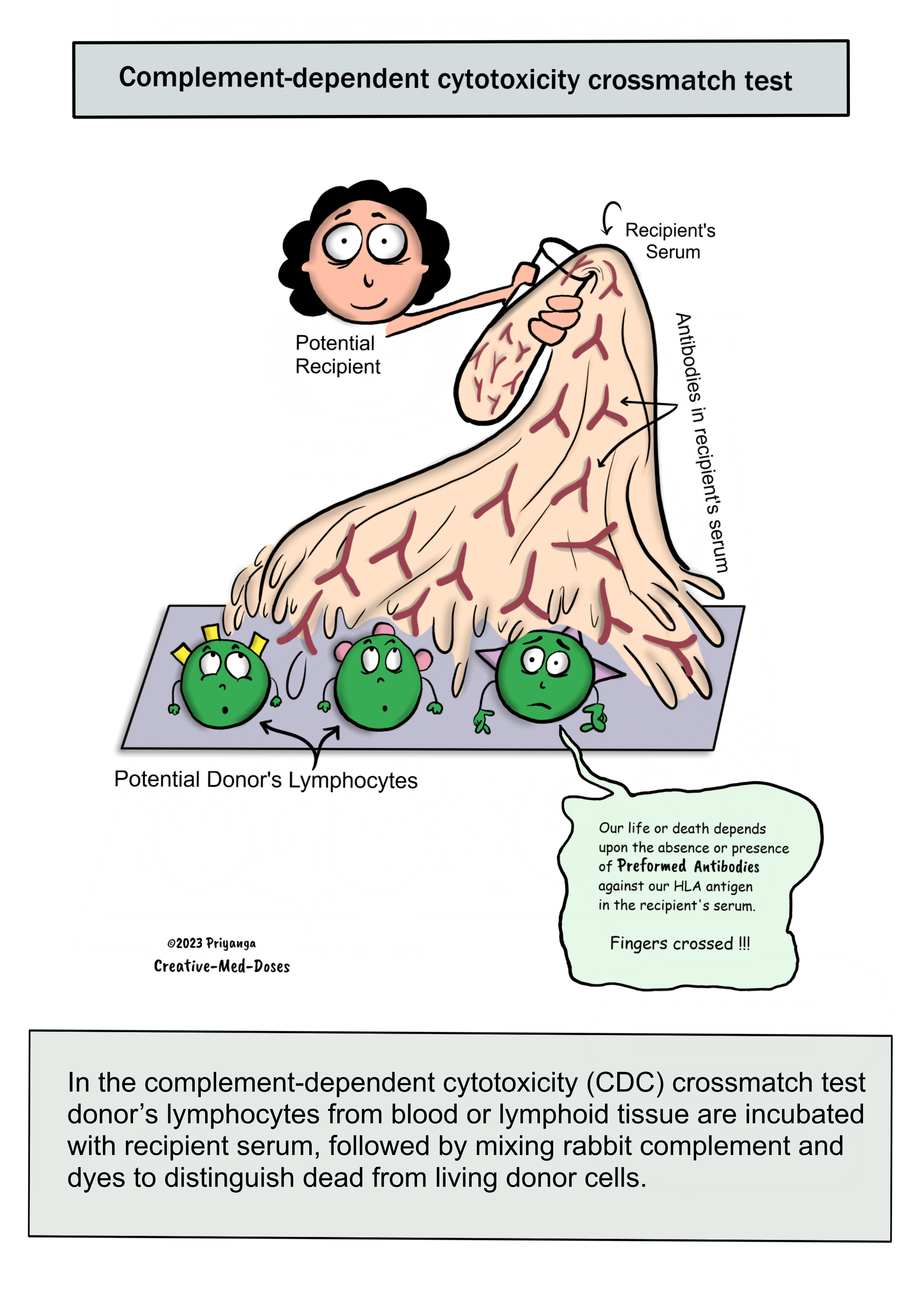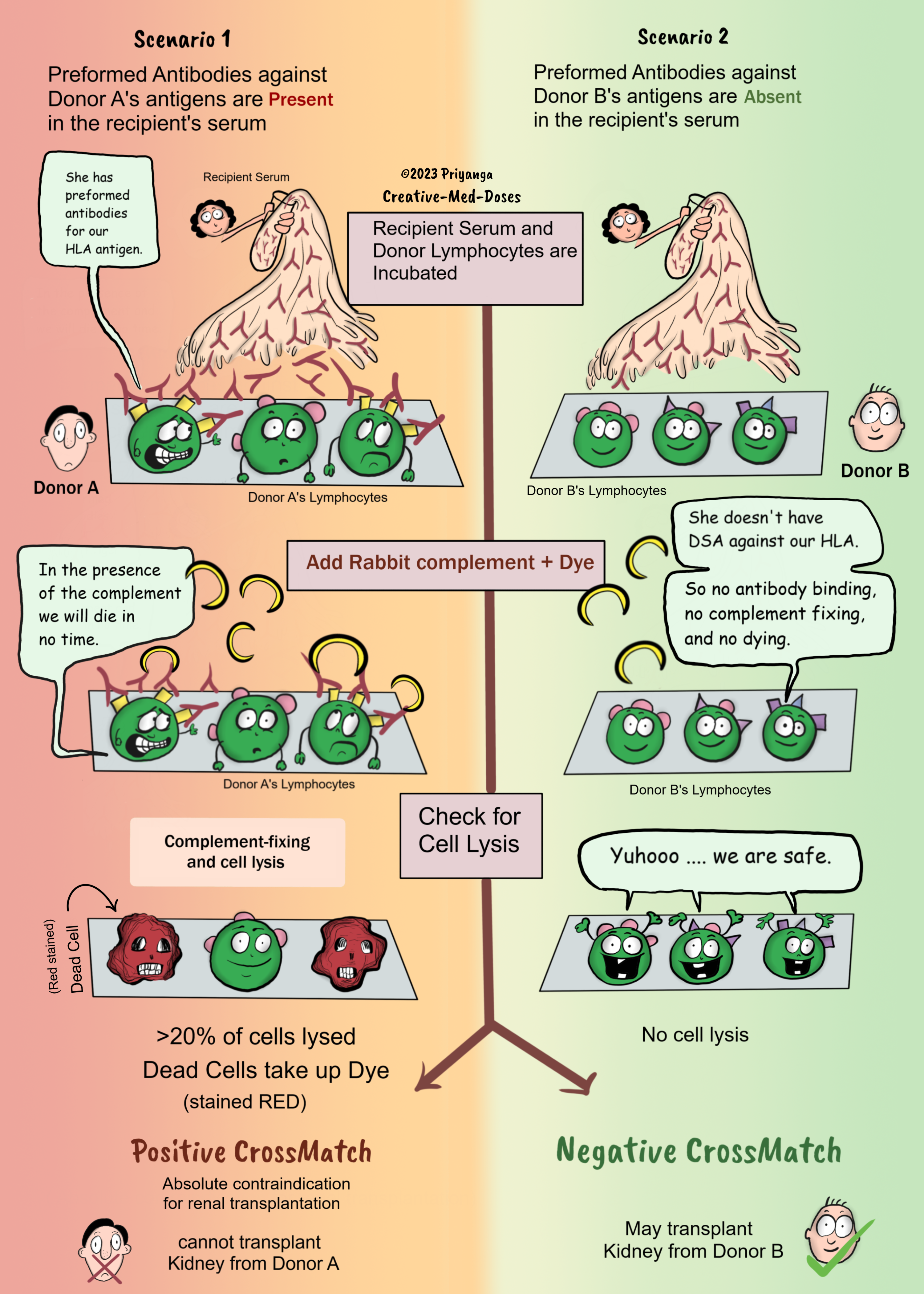Complement-dependent cytotoxicity (CDC) crossmatch
Complement-dependent cytotoxicity (CDC) crossmatch is the most commonly performed test to determine whether one should proceed with transplantation.
In the complement-dependent cytotoxicity (CDC) crossmatch test donor’s lymphocytes from blood or lymphoid tissue are incubated with recipient serum, followed by mixing rabbit complement and dyes to distinguish dead from living donor cells.
The cell membrane is not intact in lysed dead cell, so it will take up the dye and stain red (or whatever color the dye contains).
If the recipient’s serum has preformed antibodies against the donor’s antigens, there will be cell lysis after adding complement, and the dead cells will take up the dye. It is a positive crossmatch if there is cell lysis of more than 20 percent of donor cells (lymphocytes). Avoid transplantation from such donors. Positive CDC crossmatch is an absolute contraindication for renal transplantation.
It is a negative crossmatch if the donor’s lymphocytes show no or minimal cell lysis. One may go with transplantation because the donor and recipient are compatible, and the chances of early graft rejection are low.
...

...
scenario 1
Donor’s lymphocyte having HLA antigen + Recipient’s Serum with some antibodies → incubation → preformed antibodies attach to donor’s antigen → add rabbit’s complement and dye → complement fixing → activation of complement pathway and Membrane attack complex → cell lysis and disruption of cell membrane → cell takes up the dye → dead cells are stained red → Positive CDC crossmatch → donor and recipient are incompatible → Chances of early graft rejection is very high→ absolute contraindication for transplantation.
scenario 2
Donor’s lymphocyte having HLA antigen + Recipient’s Serum with some antibodies → incubation → no preformed antibodies against donor’s antigen → no antibodies are attached to the lymphocytes → add rabbit’s complement and dye → no cell lysis → living cells do not take up the dye → negative CDC crossmatch → donor and recipient are compatible → one may proceed with transplantation.
....

....
Clinical significance of antibodies detection by CDC crossmatch versus Flowcytometry crossmatch
The positive CDC crossmatch test is strongly associated with hyperacute and acute accelerated rejection in all solid organ transplants. Hence the positive complement-dependent cytotoxicity (CDC) crossmatch is an absolute contraindication for transplantation.
The positive flow cytometry test’s association with graft rejection is less robust (which means the graft may or may not get rejected). It is also associated with false positive tests.
Hence positive flow cytometry is a relative contraindication for transplantation.
Pros of CDC crossmatch
- Most commonly used.
- Detects clinically relevant complement-fixing antibodies.
Cons of CDC crossmatch
- Not automated
- High Inter-observer variations
- Only detects high levels of HLA antibodies, so AMR (antibody-mediated rejection) can occur in patients transplanted with negative CDC crossmatch. The recipient with low levels of HLA antibodies will give negative CDC crossmatch results, but low levels of preformed antibodies may cause antibody-mediated rejection (AMR).
Revision for today Barrett’s esophagus - Creative Med Doses
Revision for today Renal Hypoxia: Why kidney is prone to hypoxia and ischemic injury? - Creative Med Doses
Buy fun review books here (these are Kindle eBooks you can download Kindle on any digital device and log in with an Amazon account to read them). Have fun and please leave a review.
https://creativemeddoses.com/books/